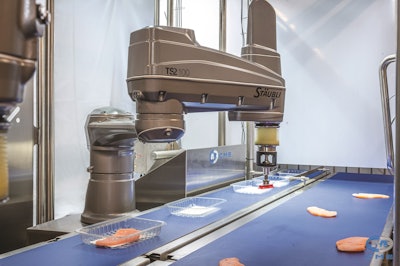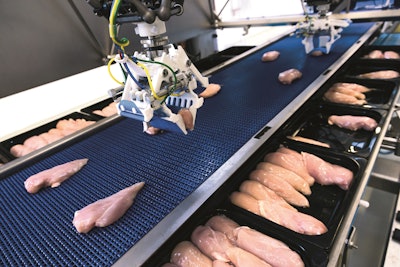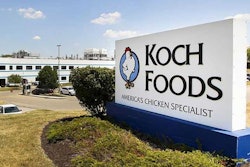
The global health crisis highlighted and exacerbated existing staffing and sanitation issues processors face. Those working to automate the poultry plant say there is greater interest now than ever before in robotics.
Poultry hanging and product packing continue to be labor-intensive areas in the plant where automation can reduce staffing needs. WATT PoultryUSA surveyed poultry processing equipment manufacturers Foodmate US Inc., Marel Poultry B/.B and Staubli Corp. to assess the state of the art picking and hanging machinery.
Robotic picking
A new generation of robotic arm technology can accurately and reliably pick and pack product from a belt.
This kind of automation, according to Roy Driessen, Marel’s marketing manager for poultry, reduces risk and labor needs. Human hands, he said, are the most critical contaminant in a poultry processing plant.
“Every touch is potentially contaminating,” Driessen said. “In an ideal world, human input would be limited to supervision only.”
The goal of processing, he said, is to move the carcass from live bird hanging to cold storage as quickly and efficiently as possible. Buffers in processing, like double handling, allow time for the temperature of the meat to rise which encourages the growth of harmful bacteria and shortens shelf life.
Automation is constantly advancing in the processing plant. For this area, the technology needs to reliably discern and collect objects of differing size, weight and shape rapidly moving down a belt. The machinery must also handle the humid and cold work environments and rigorous washdown and sanitation measures.
Technological advancements
In the past, Sebastien Schmitt, Staubli’s robotics director for North America, said this labor-intensive process required workers to stand side by side in front of the conveyor grabbing, portioning, counting, sorting and placing cuts of meat into tray packs.
New robotic arm technology, he said, is powered by visioning technology that recognizes the shape of a raw piece of chicken. These arms possess a gripper or a scraper to reliably pick product from a belt. They are also resilient enough to handle daily washdowns.
Tom Rozendaal, product and marketing manager for Foodmate B.V., said automation in this area replaces manual labor and eases the process which ultimately increases the same processing plant’s capacity.
Moreover, the machinery is constantly collecting data to improve collaboration in identifying and picking objects. This data also enables plant operators to learn more about how their plant is performing. Incremental advances in technology are making robotics less expensive to produce, operate and maintain in a poultry setting.
The machinery is ready, Schmitt said, for a world where poultry plants are already hard to staff and health risks are elevating the importance of social distancing. Robotic solutions can help poultry processors, Driessen said, meet the challenges of labor availability, ergonomics and food safety while delivering higher yield and efficiency.
Current machinery
Staubli offers a range of customizable industrial robots, controllers, supporting software and hardware for certain jobs. Schmitt said Staubli robots are making sandwiches and biscuits and are used for a variety of jobs in primary and secondary processing. The company is already large in beef, but is seeing growth in poultry, too. The COVID-19 pandemic increased demand for Staubli’s robotics more than ever before, he said.
Staubli is developing a fast-picking robot capable of handling 200 picks per minute. Its current scraper machines can handle between 80 and 100 picks per minute. The company partners with others in software and hardware to build new machines to solve unique problems in processing.
Marel offers the RoboBatcher Flex, a robot designed to replace human actions. The RoboBatcher picks and weighs each portion and places it in a tray at the desired pack weight with minimal giveaway. The machinery can handle 300 breasts per minute or 210 legs per minute. The only human input after the machine, Driessen said, is inspection.

Yield and labor
There is a tradeoff, as with all automation, between the precision of a human worker and the machine. Current picking technology still requires supervision to collect product the machinery missed moving down the belt.
Nevertheless, picking robots can reduce labor needs in an area of the plant that often employs the most people and requires the most manual operations while creating avoidable product buffers. In one case of a poultry processor, Schmitt said, Staubli’s picking robotics reduced staffing needs by two thirds.
Driessen said labor savings differ based on the specific solution. He said what’s being changed will always be a factor and the specific labor savings vary from plant to plant.
Hanging
Machinery also exists to reduce the need for workers to transfer product from one shackle line to another.
Foodmate is offering a new module, the Automatic Leg Transfer System (ALTS), that replaces laborers hanging and rehanging products and transferring it from one line to another, which is often performed between cut-up and deboning. Foodmate US Engineering Manager Travis Martin said this new product will lead the way in automation, bridging the gap between differing processing areas in the plant and offering significant labor reduction.
Manually loading product can take four or five workers per machine. Using Foodmate’s ALTS would eliminate the need for those workers, Martin said. Foodmate will launch this product in October 2021 with its first install at one of its largest customer’s plants in Kentucky.
Usage in the U.S.
Driessen said Marel’s RoboBatcher is currently widely used in Europe and there is one installation in the U.S. with another scheduled for the future. He said interest in robotics greatly increased during the pandemic when labor shortages globally reached some of the highest levels the industry has ever seen.
In Europe, automation is already fully accepted in poultry processing, Driessen and Schmitt said. In the U.S., COVID is forcing the issue for many producers. Schmitt said there was always interest in the U.S., but final approval was hard to come by. In the past year, he’s seen more willingness to say yes to automation.
“I think it’s clear that it’s a point of no return,” Schmitt said.
In the U.S., Driessen said the adoption of the RoboBatcher is still in the beginning phases. He said this change is expensive and while the product worked in Europe, some adjustments were made for the U.S. market.
“The pandemic brought with it many issues, but labor was a huge one for processors and the willingness to entertain robotics has greatly increased,” Driessen said.
How collaborative robots could simplify poultry processing. WATTPoultry.com/articles/42054


















